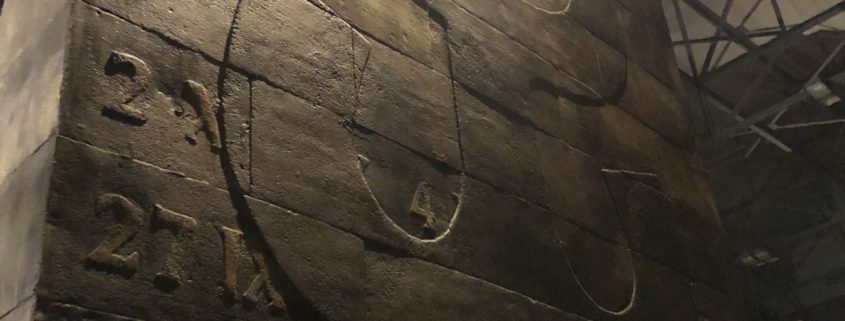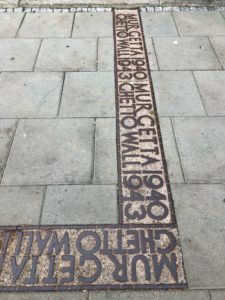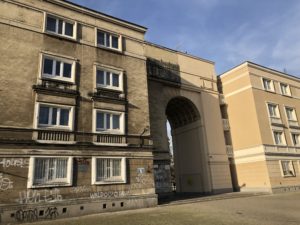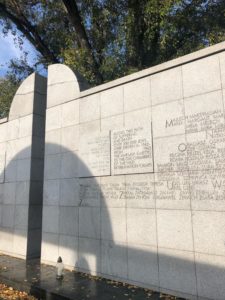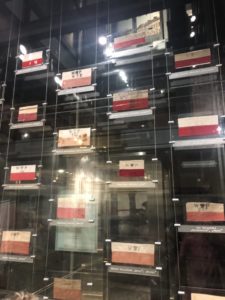Don’t Judge Poland Before You’ve Walked Centuries in its Shoes, and Don’t Judge an Uprising by its Museum
By Esmé Rummelhart
An anthropologist-in-training, I am eager to learn how the political landscape of Central Europe today intertwines with its history, and with the cultures and identities of its people. Though it is sometimes difficult for me to understand, governments here seem to lean further and further to the right, backed by public acceptance and support. In a region where (I naïvely assumed) peoples’ memory of the Holocaust should be fresh, its legacy tangible and thus its atrocities (and the sentiments which enabled them) unrepeatable, how can the electorate vote into power politicians whose nationalist agenda echoes racist, xenophobic, homophobic, and sometimes antisemitic ideologies from the Nazi era? In Poland, a country scared so deeply by World War II and Communism, how can so many people support the far-right Law and Justice party at the ballot, a party with a revisionist “historical policy” (polityka historyczna).
When people discuss the recent rise of conservative nationalism in Europe, it is often tied to the European migrant or refugee crisis of 2015. In reality, nationalism is not monolithic, and comes in varieties as diverse as the people and countries toting the ideology. To begin understanding Polish nationalism in a productive as opposed to judgmental manner, I first had to begin understanding Poland’s difficult and troubled history as a nation. I emphasize begin because I still have much to learn, and as you will read here, I only describe this history in brief.
During the 16th and 17th centuries, the Polish-Lithuanian Commonwealth became one of the largest and most powerful states in Europe, reaching from the Baltic Sea nearly all the way to the Black Sea. After existing for nearly two centuries, it was partitioned by Austria-Hungary, Russia, and Prussia in three stages, 1773, 1793, and 1795, at which point Poland ceased to exist altogether. Still, many people held on to their Polish cultural identity for over a century, some forming a sense of Polish national identity in hopes of self-governing one day, until these hopes became a reality. Following the First World War, Poland gained its independence through the Paris Peace Conference and entered a turbulent period of nation building – first as a parliamentary democracy and then under authoritarian rule.
But the Second Polish Republic was short-lived; on September 1st, 1939, Nazi Germany invaded Poland from the West beginning World War II. Just weeks later, on September 17th, the Soviet Union invaded from the East and met Germany at the Molotov Ribbentrop line as Hitler and Stalin had previously agreed. Poland suffered immeasurable losses during the war, at the hands of both Nazism and Stalinism. In 1940, the Soviet secret police – the NKVD – murdered an estimated 23,000 polish cultural elite in what is known as the Katyn massacre. By the end of the war, over 6,000,000 Poles had lost their lives, over 3,000,000 of them Polish Jews. This does not include Jewish people and other minorities from outside Poland who were transported to killing centers or ghettos within the country, to be murdered on Polish land. An independent, democratic Poland would not exist again until after the collapse of communism; the Polish Roundtable Agreement in 1989 opened the door for semi-free elections later that year, which saw overwhelming support for Solidarity candidates and the election of Tadeusz Mazowiechki, the first non-communist prime minister. Even with this history given only in broad strokes, the isolationist, nationalistic ideologies of many Poles today becomes easier for me to understand, their distrust of perceived ‘outsiders’ more founded if still prejudice.
My experience in Warsaw only deepened my understanding of Polish history and identity prompting further self-reflection on my part, compelling me to challenge my harsh judgements about Polish nationalism. I explored predominantly the period during and immediately after WWII during this visit, through class sessions, reading materials, and museum tours.
Warsaw Rising is one such museum, focused on the Warsaw Uprising of 1944 and the people, many of whom were members of the Home Army (AK), who actively resisted occupation. The museum was opened on July 31st, 2004, on the 60th anniversary of the event which it intends to commemorate and operates with support (economic and otherwise) from the city and private funders. Its orientation is criticized as propagandistic or nationalistic by some, and rightfully so. This museum immerses visitors, using interactive exhibits to convey a specific moment in Warsaw’s history – one of the Warsaw uprisings – through a narrow, glorified lens. After elaborating on the history of the Warsaw uprisings (including the Warsaw Ghetto Uprising of 1943), I will return to discuss my perception of Warsaw Rising, and how my understanding of Poland’s past complicates my ability to simply condemn or condone the museum’s messaging.
Prior to my semester in Central Europe, I knew virtually nothing of Poland’s complex and painful past, least of all about the two uprisings which occurred in Nazi-occupied Warsaw during 1943 and 1944. I won’t get in to the valuable specifics of these events, but I will try and give an accurate, honest overview. Following the invasion of Poland in September 1939, in October of 1940, the Nazi government in Warsaw falsely claimed that Jewish people had typhus and thus needed to be separated from the rest of the city; the Warsaw Ghetto was created, and in November of the same year, it was sealed. The largest ghetto under German occupation, it imprisoned over 400,000 Jewish people at its peak. Conditions within the ghetto quickly became horrendous. Then from July through August of 1942 as part of the Final Solution, around 300,000 Jewish people were transported to the extermination camp Treblinka. Known as the “Large Action,” those transported were predominantly women, children, and the elderly – anyone who couldn’t be used for labor. Many of those remaining were younger men who sensed their inevitable death, and in the absence of families little left to lose. Though diverse in their ideologies and tactics, they organized and began to arm themselves with the help of the Polish Home Army outside the ghetto walls; so, when the Germans received orders to liquidate the Warsaw Ghetto in January of 1943, they were met with Jewish armed resistance.
After four days of fighting during which the Germans murdered and deported several thousand Jews, the Germans had to retreat and regroup. When they returned in April, they were met again with strong resistance in an event that became known as the Warsaw Ghetto Uprising. Both sides took casualties, but ultimately the Germans set the entire ghetto ablaze; countless residents were burned to death, and by mid-May, nearly 60,000 Jews had been captured and either shot or deported. Many of those who survived would join the resistance outside of the former ghetto, going on to organize and fight with the Home Army in the year to come.
The Warsaw Ghetto Uprising barely figures into the Warsaw Rising museum however – in fact, it is hardly peripheral. Instead, the museum focuses on the story of the Polish uprising which began on August 1st, 1944 and lasted for two months. This uprising was led, and predominantly fought, by the Home Army, but other resistance groups joined its ranks. The buildup was years in the making; Poles experienced terror at the hands of the Soviets and Nazis alike. After the fall of the Jewish uprising, the former ghetto had been turned into a concentration camp for Poles and mostly non-Polish Jews, atop the ruins of buildings containing still-rotting bodies. Poles who supported resistance as well as random citizens were regularly rounded up and shot or hanged. Poland’s supposed allies had not, or could not, come to its defense. But finally, in late July of 1944, the Red Army was fast approaching Warsaw. Under the assumption that the Germans would retreat as the Soviets drew nearer, the exiled Polish government gave the Home Army permission to begin an uprising, in the hopes that Poles could ‘liberate’ their own capital city before the Soviets arrived. The first day was deadly and somewhat disorganized, but rather successful; the Home Army failed to capture important military targets but did gain territory in the city.
Just days later, the Home Army defeated SS guards and liberated the few hundred (mostly Jewish) prisoners who remained in Concentration Camp Warsaw, many of whom joined the fight. Unfortunately, the Red Army had slowed down. Instead of joining the Home Army in direct combat against the Germans, the Soviets stopped their advance just shy of Warsaw. Assistance did not come, and the two months that followed were unspeakably brutal and deadly. The Wola neighborhood is one of the most horrendous examples; in a number of days, the Germans murdered over 30,000 Polish civilians, loosing just six of their own soldiers, and burning everything as they went. At the hands of the Germans, Warsaw was destroyed. Hospitals were burned with the patients still inside, nurses and nuns raped and murdered, men and women hanged. Though it is impossible to pinpoint, estimates of Polish civilian deaths in Warsaw reach 200,000.
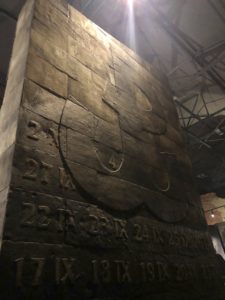
A ceaseless heartbeat pounds from central column in the Warsaw Rising museum, bearing the symbol of the Polish resistance
The Warsaw Rising museum glorifies this 1944 uprising in an intensely patriotic light. Information – stories of individuals, children, families, every-day people forced to be heroic given unspeakable circumstances – surround viewers from every angle the moment you step through the door. I was greeted by a low, ceaseless, steady pounding, a powerful heartbeat, which remained in my ears no matter which corner I found myself in, or which or floor I found myself on. The artifacts are fascinating; uniforms, arm bands, letters, weapons, photographs, and a real fighter plane all made me feel how real this uprising was. The museum does not falsify history, and its glorification of Poles fighting for an independent Poland does not seem excessive. This museum is about real people who did truly extraordinary things. However, given the connections between the two Warsaw uprisings, their aims and those who fought in them, it is noteworthy that the Warsaw Rising museum does little to include the Warsaw Ghetto Uprising.
Warsaw Rising’s goal is to convey a part of Polish history which Poles today can be proud of. Given Poland’s traumatic past, I can easily understand the desire to uphold the Warsaw Uprising as a symbol of the country’s courage and strength, the desire to carry the spirit of this event into the future. Where I was initially quite judgmental of Poland’s turn towards nationalistic or isolationist policies in recent years, after becoming more informed about Poland’s history, I feel like I can no longer dismiss this shift as ignorant. I cannot pass judgement on Polish people or voters, because I’m only beginning to understand their history, what they’ve been through, and how that informs their priorities and values today. Partitioned for centuries, unassisted by its allies and betrayed by its supposed Soviet liberators during World War II, and stifled under the Soviet regime for decades, I see how the Polish nationalist sentiments of today are tied to this past.
Nationalist sentiments do not simply draw from this past however; they are used by those in power to coopt, pervert, and then weaponize Poland’s history, skewing it to legitimize exclusive narratives and sow seeds of fear. The ruling Law and Justice party and its policies serve as a prime example of such strategic use of history. Their ‘historical policy’ follows the revisionist logic that Poland should not be reflexive in dealing with its history (which they frame as being ‘ashamed of its past’), and museums are an important battleground for promoting this ideology. Instead of questioning, investigating and attempting to reconcile past crimes – against Jewish people and other minorities at the hands of fellow Polish citizens and the state during the past century – the far-right government in Poland today explicitly denounces research in such areas and chooses to frame history very narrowly, as we see on display at their Warsaw Rising museum.
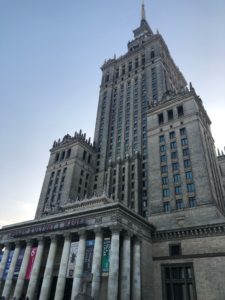
The Palace of Culture and Science in Warsaw, erected at the direction of Stalin as a ‘gift’ to Poland following World War II
This is the government which, in 2018, put a law in place banning people from saying that Poland was in any way complicit during the Holocaust. Those convicted faced up to three years in prison, a sentence which has since been retracted and replaced with a fine after international backlash. The law is an extension of the party’s historical policy, born simultaneously as an effort to construct Poland’s innocence, and to simplify or censor Poland’s history (excluding the Warsaw Ghetto Uprising from the Warsaw Rising museum, for example) to fit their whitewashed narrative. Many Poles today oppose this policy and the party behind it, valuing what we can learn today form a true and unabridged understanding of Poland’s history. But how do so many others vote Law and Justice into power? The party uses populism – planting baseless seeds of fear and vulnerability in its constituents to mobilize voters – be it conspiracy theories about internal and external plots to compromise Poland, or concerns about practically nonexistent refugees “flooding” the country. Museums, such as Warsaw Rising, are used to ideologically frame, focus, or uphold these lies.
It was not the Warsaw Rising museum and its illustration of events which made me especially sympathetic towards the Polish nation or the sentiments, but the extended history which I had learned previously, through readings and discussions. Visiting the museum, I simply witnessed a portion of this history revived for an audience of today. Even if I don’t agree with all aspects of the museum, I see the powerful message it sends, and recognize why so many Poles (and tourists alike) visit and applaud the museum. Nationalism is counterproductive and damaging to society (especially to marginalized individuals within it), but it does not appear out of nowhere. Politicians and even grassroots right-wing movements strategically adopt populist rhetoric to prey on peoples’ fears and feelings of vulnerability, sentiments founded on real experiences or perceptions. Poland’s history is so rich that it speaks for itself if given honest attention, but danger arises when history is censored for political purposes. To move forward and truly heal history’s wounds, patience and understanding must flow both ways.

